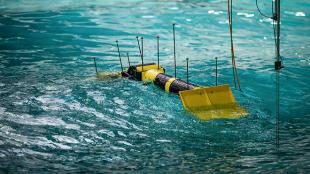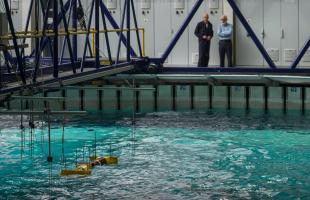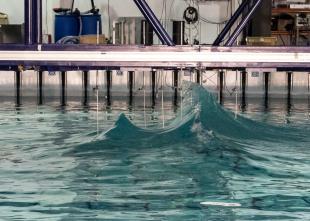Mocean
Edinburgh-based Mocean Energy have been a key client for FloWave through test programmes under the Wave Energy Scotland (WES) Novel Wave Energy Converter programme, and later under the EuropeWave PCP programme. Mocean specialise in hinged raft attenuator devices, generating power at the hinge of the device. Mocean have successfully taken their prototype 10 kW Blue X device from FloWave testing all the way to field testing at EMEC in Orkney, and have tested their next development, the 250 kW Blue Horizon, through prototype stages at FloWave in 2022. Blue Horizon is expected to provide essential power to remote island communities around the world as well as for supporting offshore marine energy rigs.
HAPiWEC
Holistic Advanced Prototyping and Interfacing for Wave Energy Control, or HAPiWEC for short, is a wave energy research project being developed by The University of Edinburgh and the University of Strathclyde, funded by EPSRC. HAPiWEC is part of a drive to reduce the levelized cost of energy for wave energy. Improved control is likely to be key tool in achieving this, and HAPiWEC aims to remove many of the barriers in testing these control techniques. This is achieved by developing a remotely controllable modular wave energy test rig which can be altered by clients to suit their testing needs without the requirement for building their own model. This model would be based at FloWave and so will allow clients around the world to utilise the FloWave facility regardless of the development stage they are at or their geographical location.
Wave breaking in crossing seas
There have been numerous studies looking into wave mechanics at FloWave including the, EPSRC-SFI funded, WBICS project, led by the University of Oxford collaborating with the Universities of Edinburgh and Manchester, and University College Dublin. For thousands of years so called “rogue waves”, waves that appear to reach much steeper gradients and heights without breaking, have been reported by those who spend time at sea. It is hypothesised that crossing waves may increase the wave breaking steepness limit, changing our current understanding of these rogue events. FloWave tests, undertaken by Dr Ross Calvert, use a high-density wave gauge array to generate spatially rich datasets for validation of numerical and statistical models developed by the project partners.






